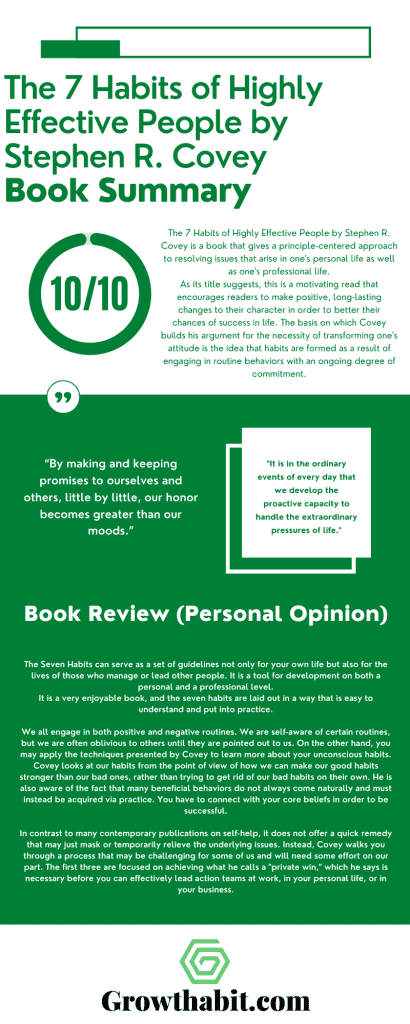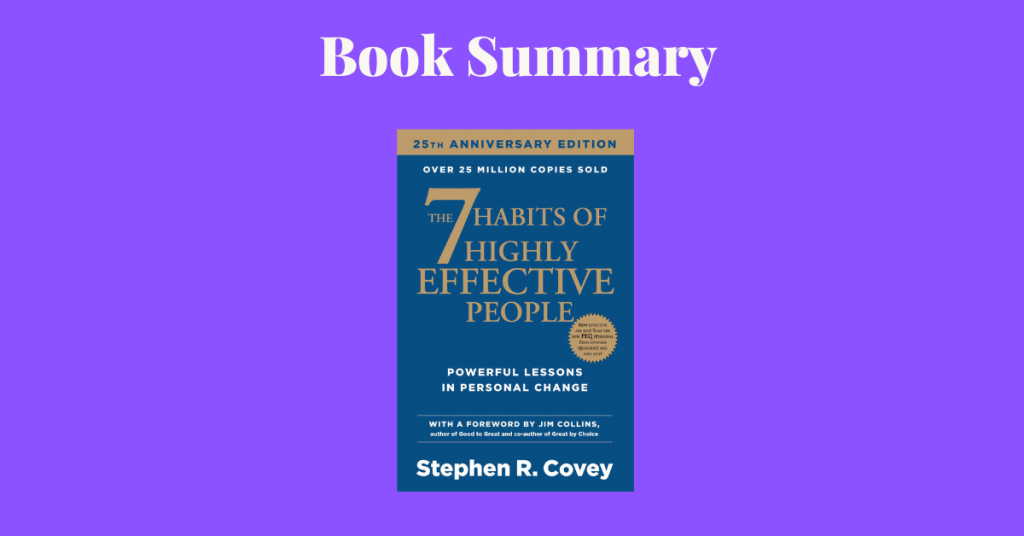The 7 Habits of Highly Effective People by Stephen R. Covey is a book that gives a principle-centered approach to resolving issues that arise in one’s personal life as well as one’s professional life.
As its title suggests, this is a motivating read that encourages readers to make positive, long-lasting changes to their character in order to better their chances of success in life. The basis on which Covey builds his argument for the necessity of transforming one’s attitude is the idea that habits are formed as a result of engaging in routine behaviors with an ongoing degree of commitment.
Stephen R. Covey provides a step-by-step approach to living with justice, integrity, honesty, and human dignity. These are the values that give us the security to adapt to change as well as the knowledge and power to take advantage of the possibilities that change creates. He does this with incisive insights and practical examples.
Book Title— The 7 Habits of Highly Effective People
Author— Stephen R. Covey
Date of Reading— September 2022
Rating— 10/10
What Is Being Said In Detail
Part 1. Inside-Out
Covey opens the book by claiming that he has struggled with a wide variety of personal and professional issues, such as balancing personal and professional responsibilities, failing to achieve personal objectives, failing to build meaningful relationships, and having trouble as a parent or a partner. Covey then explains what a paradigm is.
A paradigm is an outlook on life that serves as a mental model for making sense of the information we receive. A paradigm can be thought of as a guide for tackling a problem or situation. Each of us carries about two separate mental maps: one representing the current state of affairs (reality) and the other depicting how we would ideally want things to be (values). We seldom evaluate these maps, but it is critical to check our assumptions and be willing to change them. Although we can work on altering our actions, genuine and lasting transformation can never occur until we also alter our mindsets.
A lot of recent books on self-help give simple, but superficial, ways to make changes. Older “success literature,” on the other hand, focused on having good morals. These two methods can be classified according to their respective “ethics.”
In this specific case, he elaborates on how Personality Ethic is focused on things like external appearance, social standing, and interactions at a superficial level. It uses simple, manipulative methods to get people to like you or make them afraid of you so they will respect you.
Among the tenets of the Character Ethic are honesty, modesty, bravery, justice, and tolerance. At its core, it is concerned with the ideals that underlie all human action. This ethic prioritizes living by universally accepted norms of compassionate life over social position. Paradigm shifts occur when one adopts the Character Ethic as their guiding principle and so develops the ability to define objectives in accordance with these principles.
People who work with an outside-in paradigm see themselves as the victims of other people’s flaws or of less-than-ideal situations. The Personality Ethic underlies the workings of this paradigm. It makes it possible for individuals to be duped into thinking that complex issues have simple solutions. By adopting an introspective frame of mind, we might start to see that our actions have consequences in the external world. The inside-out strategy bases all changes on a set of fundamental concepts and ideals.
We need to do more than just shift our routines if we want to evolve. Instead, we need to adjust our perspective of the world and of ourselves in it. By turning our thinking around from the inside out, we may change our paradigm and bring our choices and behaviors back in line with our deepest principles.
The Seven Habits—An Overview
A habit, according to Covey, is the junction of knowledge, skill, and desire. To form a habit, you must have knowledge of what to do and why, the ability to do it, and the desire or motivation to do it. Change might be difficult or unpleasant, yet the process can lead to happiness. You can’t pick and choose which of the Seven Habits works because they all operate together. They also exist on a maturity scale. The paradigm of reliance is at the low end; in other words, you are accountable for what occurs to yourself.
Society places a high priority on independence, while cooperation is the peak of maturity. Being interdependent implies that you are self-sufficient and have control, but you choose to be emotionally and intellectually linked, accepting affection and ideas from others. The Seven Habits are all about efficiency. Maintaining an effective balance between productivity (“P”) and production capability (“PC”) is required. The “P” in “The Goose That Laid the Golden Egg” represents the “product,” or the golden egg. The goose represents the “PC,” or the asset with the ability to generate. P will suffer if you are overly focused on P rather than PC, or if you do not invest in PC.
For example, if you operate a machine too hard or push your people too hard in order to produce more, you will soon discover that the result is not as good: the equipment will wear out or the personnel will perform at subpar levels due to exhaustion. P/PC balancing requires investing in all stages of the manufacturing process.

The Seven Habits promote proper P/PC balance. The habits are also sequential: one follows the other. The first three habits generate self-mastery by establishing a strong inside-out, principle-centered paradigm. Habits 4–6 promote strong relationship-building. The seventh habit is a continuation of the preceding six. When you combine all of the habits, you have the ability to function well in both alone and group settings.
Part Two: Private Victory
Habit 1: Be proactive
Being proactive entails taking charge of one’s own life. Proactive individuals are “responsible” because they believe they have control over how they respond to situations. Proactivity is compared with a perspective of oneself based on the theory of determinism, which can be divided into three subcategories: genetic determinism, which states that you are who you are because of your DNA; psychic determinism, your childhood experiences have permanently established your character structure; and behavioral determinism, which says that you are who you are because of your behavior, and environmental determinism, which holds that your environment dictates your life condition. People who allow such factors to rule their life are said to be “reactive.”
As humans, we have various distinguishing characteristics, including self-awareness, imagination, consciousness, and free will, or the ability to act on the first three. Therefore, we have the option to form our own interpretation of events.
Effective people devote their resources to the things inside their Circle of Influence. Reactive people, on the other hand, focus their energies on matters over which they have no control, such as other people’s actions and inevitable events. They tend to belabor other people’s weaknesses and spend time fantasizing about how their life would be better if they only had what they want, such as a better job or a new boss. This reactive strategy approaches problems from the outside in, rather than the inside out. Reactive language emphasizes “having” above “being.”
To be proactive, you have to change how you see and talk about your problems and shift your focus. People that are proactive don’t simply react to what happens, but rather use their intelligence, imagination, and morality to decide about the best course of action.
A proactive person does not waste energy attempting to control things outside of their Circle of Influence, but rather attempts to change from inside.
Habit 2: Begin with the End in Mind Principles of Personal Leadership
Habit 2 is founded on the idea that “everything is created twice.” There is a conceptual creation, such as a plan for a structure, followed by a physical creation, such as the building’s construction. When starting a business, it is necessary first to determine the business goals and then arrange all aspects of the firm around those goals. This is also true in other areas of life, such as parenting. Parents who want to raise responsible, self-confident children must keep these aims in mind every day and treat their children in ways that do not contradict these principles. Personal leadership is also at the heart of Habit 2. The first (mental) creation is leadership, and the second (physical) creation is management. To put it another way, leadership is the vision or plan, whereas management is the building. Personal leadership requires a personal purpose statement. A mission statement should include the following information.
- Who you aspire to be.
- What you intend to achieve.
- The guiding concepts and ideals from which decisions will be made.
A personal goal statement provides you with a firm foundation for being the leader of your own life, so you no longer have to follow the scripts of others.
Each of us has a life center that serves as a basic paradigm. Family, money, work, pleasure, and religion are all examples of different centers. We can even let an adversary to become the focal point of our existence, consuming our thoughts and influencing our actions. People frequently have many centers or change between centers. The objective is to have a single, distinct core founded on sound ideas. Principles are profound, underlying facts that do not alter in response to external events.
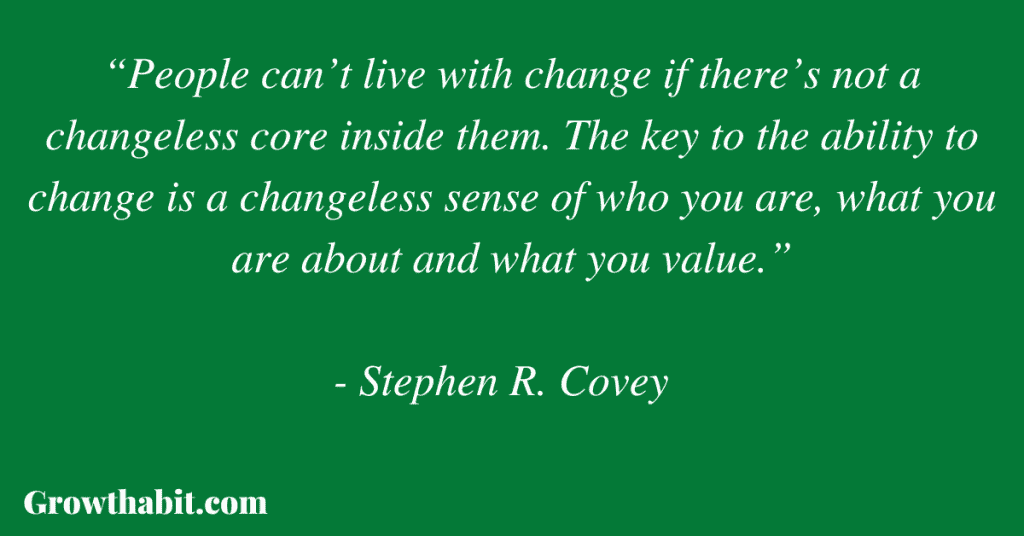
To put together a personal purpose statement, one must devote significant time and thought to the task. It needs you to use both sides of your brain and broaden your perspective. It also requires envisioning your objectives and expressing your conviction in your ability to achieve them. It is useful to consider the roles you already play that are significant to you, as well as the goals you have for each of those positions.
Begin each day by picturing your life objectives in order to begin with the end in mind. This entails projecting not only what you want to achieve, but also who you want to be and what values you want to live by. Writing a personal mission statement assists you to establish your character objectives and organize your life to fulfill those goals.
Habit 3: Put First Things First Principles of Personal Management
The “second creation” is the embodiment of concepts and a vision based on those ideas, which is the focus of Habit 3. After awareness of oneself, creativity, and morality, independence of will is the most valuable human trait. To build this will, we need to be honest, which lets us keep our promises. Understanding how to manage one’s time well is essential for Habit 3, but it’s more crucial to learn to control one’s own time. Covey’s four-quadrant framework for managing time is based on the four fundamental categories of human endeavor.
Quadrant I: Important and Urgent
Quadrant II: Important but Not Urgent
Quadrant III: Urgent but Not Important
Quadrant IV: Not Urgent and Not Important
Successful self-management entails focusing most of one’s efforts in Quadrant II. Investing more time in this area makes it less likely that problems will arise in the first quadrant. We need to get better at saying “no” to things in Quadrants III and IV if we’re going to have time to focus on things in Quadrant II.
The “first things” that should be put first are in Quadrant II. When planning how to use our time, we should set priorities based on our values and personal goals. The most effective strategy for doing so is to plan your activities for the week ahead rather than each individual day. In comparison to a daily planner, a weekly planner will provide you more breathing room to strike a healthy balance. There are four main components to a timetable that prioritizes Quadrant II:
1. Establishing Responsibilities.
2. Choosing Objectives
3. Scheduling
4. Change and growth every day
Delegation is an essential part of effective management. You can delegate something either way. Gofer delegation means giving orders for everything.
Stewardship delegation means giving tasks to people you trust enough to let them take care of them on their own. This last type of delegation takes longer at first because it takes more time to talk about, but it leads to better results in the end. The management needs to set expectations for outcomes, guidelines, resources, accountability, and sanctions early on.
That is to say, successful people plan their days according to their values and sense of purpose, and they devote the majority of their time to doing activities that contribute to their larger objectives. To put it simply, the “first things” you prioritize should be the ones that mean the most to you personally.
Part Three: Public Victory Paradigms of Interdependence
Interdependence cannot exist without actual independence. Effective people have an Emotional Bank Account to ensure they continue to have positive connections with others. That is a storehouse of good will with another individual or people. Meaningful conversations are the currency that fund this account. Deposits can be made into the account in one of six main ways.
1. Coming to terms with the person’s uniqueness
2. Paying close attention to detail
3. Keep your promises
4. Making expectations clear
5. Having personal integrity
6. Giving unconditional affection, following the laws of love and life.
In other words, only individuals who have mastered the first three habits and are truly independent are capable of dependency. The Emotional Bank Account model encourages the formation of routines that lead to public triumph or collaborative achievement.
Habit 4: Think Win/Win Principles of Interpersonal Leadership
Some managers think that by making their personnel compete with one another, they can get better outcomes. The goal of a Win/Win paradigm is to ensure that all parties involved in an interaction gain from its outcome. This is a more principle-based paradigm, since it tries to make sure that everyone wins. In a Win/Win situation, there are five factors to consider.
1. Character. Integrity, maturity, and an abundant mindset are the three most important qualities for a Win/Win relationship. Maturity permits one to take into account the perspectives of others and move beyond binary thinking. The mentality of abundance functions on the assumption that all needs can be met. It comes from a deep sense of personal worth and security.
2. Relationships. The strength of one’s character is a foundation for their interpersonal connections. Win/Win requires the confidence that comes from a full Emotional Bank Account.
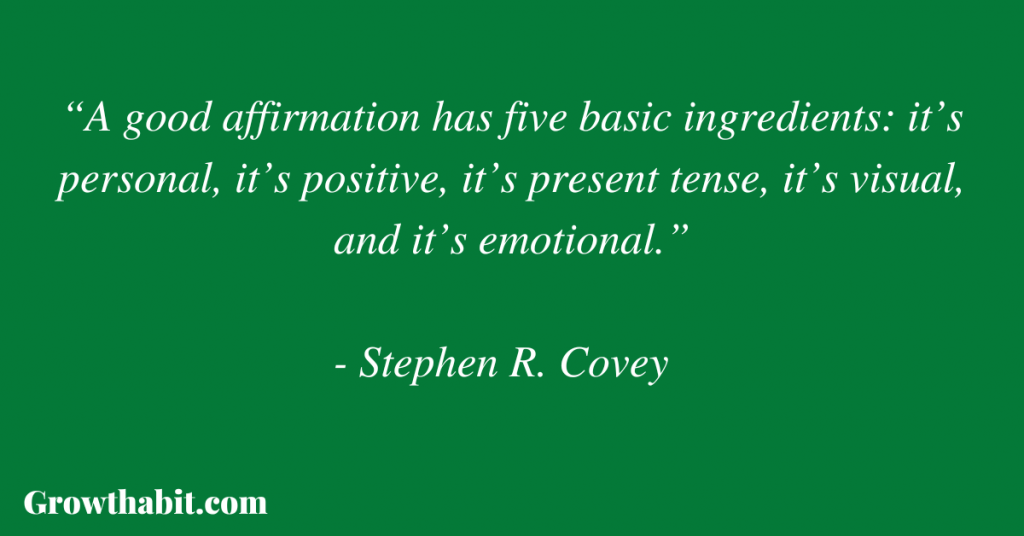
3. Agreements. The agreements that bring about Win/Win situations are the result of strong connections. Desired outcomes, guidelines, resources, accountability, and consequences are the five pillars of Win/Win agreements.
4. Systems that help out for win-win to work, there must be internal structures to facilitate it. Systems of this sort include educational offerings, lines of communication, financial planning, and financial incentives that all favor a win-win scenario.
5. Methods: Win/Win cannot be attained using Win/Lose or Lose/Win processes. Win/Win processes, which are used in operations, are necessary to achieve these aims.
Habit 5: Seek First to Understand, Then to Be Understood Principles of Empathic Communication
Communication is the most important skill to have in life. But few of us know how to listen in a way that is honest and thoughtful and helps us understand the other person well. This is exactly what you need to do to communicate well.
Few listen with the intent to comprehend; most listen solely so that they can then talk. They are eager to share their own experiences with others, even if those experiences may not work as a template for the situation at hand. This involves imposing one’s own values and worldview on others. To listen with the intention of understanding is the essence of empathy. Not like “active” or “reflective” listening, which might result in rote memorization rather than true understanding. To listen with empathy, one must put themselves in the other person’s shoes. You may disagree with that individual, but you can empathize with them and see things from their perspective. Listening with empathy adds a lot of money to the emotional bank account. Listening with empathy satisfies a basic human need by allowing the other person to feel that they have been heard and validated.
Habit 6: Synergize Principles of Creative Cooperation
In this chapter the author explains the concept of synergy. Synergy is when two or more people work together to make something that is better than the sum of its parts. It takes a lot of trust, working together, and good communication. It is the essence of working together as a team.
To communicate synergistically, you have to be open to new ideas and not be defensive or protective. It works on a higher level than even respectful communication, in which people can respect each other’s paradigms but may not fully understand them. Respectful communication can lead to a compromise or a low-level Win/Win, but it doesn’t have the creative spark of synergistic communication.
Convery then talks about what he calls “the third option.” It means a whole new way of thinking that is neither your way nor my way nor a middle ground. Instead, people are open to new ideas and ways of working together to find solutions. To find a third option, you must be willing to try new things or listen to new ideas. This is a great way to work together and think creatively.
Every person has something to offer. By appreciating how different people are, you stop trying to change them and can work with them to get past the limits that come from having different points of view. When all of the first five habits are used, synergy starts to happen.
Part Four: Renewal
Habit 7: Sharpen the Saw Principles of Balance and Self-Renewal
The other six habits can’t exist without Habit 7. It protects and improves its own wellbeing. Sharpening the saw is a metaphor for renewal in the four main areas of life.
1. Physical. Taking care of one’s physical health involves things like eating right and getting enough sleep. It also requires building up your strength and endurance. Even though it’s never an emergency, Quadrant II should include exercise because it helps avoid health issues and keeps us energized.
2. Spiritual. Since your spirituality provides you with leadership and is an integral element of your core values, this aspect is connected to Habit 2. Many things can help revitalize this aspect of oneself, such as meditation, praying, reading great literature, listening to music, or spending time in nature. These are all examples of things to do in Quadrant II.
3. Mental: After we finish our formal schooling, many of us stop engaging in challenging mental activities. Yet learning outside of formal institutions might help one’s thinking grow. Reading, increasing one’s cultural awareness, writing, organizing, and planning are all excellent ways to refresh one’s mind.
4. Social/emotional. The “public victories” of Habits 4, 5, and 6 are the focus of the fourth dimension. Maintaining social connections is vital to one’s sense of personal safety and the development of one’s own sense of purpose.

The four motivations that organizational theory addresses are the material (physical), the social, the developmental (mental), and the instrumental (the organization’s service, work, or contribution) (spiritual). Consistently expressing all four drives and engaging in all four facets of life is what it means to “sharpen the saw.” It’s crucial to provide equal attention to each of these areas and schedule some time for rejuvenation in each of them without letting any of the others slide.
An organization will be less effective if it pays insufficient attention to any of these factors. For instance, if it places too much emphasis on financial incentives while overlooking crucial aspects of interdependence, it will fail. Renewing your body, spirit, mind, and relationships is essential to implementing Habits 1-6. Those things you need to do to keep your body and mind healthy belong in Quadrant II of your weekly planner.
Most Important Keywords, Sentences, Quotes
Part 1. Inside-Out
“We must look at the lens through which we see the world, as well as at the world we see, and that the lens itself shapes how we interpret the world.”
“We began to realize that if we wanted to change the situation, we first had to change ourselves. And to change ourselves effectively, we first had to change our perceptions”
“Two people can see the same thing, disagree, and yet both be right. It’s not logical; it’s psychological.”
“We see the world, not as it is, but as we are──or, as we are conditioned to see it.”
“Admission of ignorance is often the first step in our education.”
“As you care less about what people think of you, you will care more about what others think of themselves.”
“Our behavior is a function of our decisions, not our conditions. We can subordinate feelings to values. We have the initiative and the responsibility to make things happen.”
Habit 1: Be proactive
“The ability to subordinate an impulse to a value is the essence of the proactive person. Reactive people are driven by feelings, circumstances, conditions, and their environment. Proactive people are driven by values–carefully thought about, selected and internalized values.”
“It’s not what happens to us, but our response to what happens to us that hurts us. Of course, things can hurt us physically or economically and cause sorrow. But our character, our basic identity, does not have to be hurt at all. In fact, our most difficult experiences become the crucibles that forge our character and develop the internal powers, the freedom to handle difficult circumstances in the future and to inspire others to do so as well.”
“By making and keeping promises to ourselves and others, little by little, our honor becomes greater than our moods.”
“It is in the ordinary events of every day that we develop the proactive capacity to handle the extraordinary pressures of life.”
Habit 2: Begin with the End in Mind Principles of Personal Leadership
“Real success is success with self. It’s not in having things, but in having mastery, having victory over self.”
“Habit 2 says we don’t have to live with these scripts. We are response-able to use our imagination and creativity to write new ones that are more effective, more congruent with our deepest values and with the correct principles that give our values meaning.”
“People can’t live with change if there’s not a changeless core inside them. The key to the ability to change is a changeless sense of who you are, what you are about and what you value.”
“Too many vacations that last too long, too many movies, too much TV, too much video game playing–too much undisciplined leisure time in which a person continually takes the course of least resistance gradually wastes a life. It ensures that a person’s capacities stay dormant, that talents remain undeveloped, that the mind and spirit become lethargic and that the heart is unfulfilled. Where is the security, the guidance, the wisdom, and the power? At the end of the continuum, in the pleasure of a fleeting moment.”
Habit 3: Put First Things First Principles of Personal Management
“The principles don’t change; our understanding of them does.”
“When the trust account is high, communication is easy, instant, and effective.”
“A good affirmation has five basic ingredients: it’s personal, it’s positive, it’s present tense, it’s visual, and it’s emotional.
“In the name or professional success, they may neglect the most precious relationships in their lives.”
“time management’ is really a misnomer–the challenge is not to manage time, but to manage ourselves.”
“[…]If you were to fault yourself in one of these three areas, which would it be: (1) the ability to prioritize; (2) the inability or desire to organize around those priorities, or (3) the lack of discipline to execute around them, to stay with your priorities and organization?”
Part Three: Public Victory Paradigms of Interdependence
Habit 4: Think Win/Win Principles of Interpersonal Leadership
Externally imposed disciplines and schedules give people the feeling that they aren’t responsible for results.”
“ […] can success in your profession compensate for a broken marriage, ruined health, or weakness in personal character?”
Your planning tool should be your servant, never your master. Since it has to work for you, it should be tailored to your style, your needs, your particular ways.”
Habit 4: Think Win/Win Principles of Interpersonal Leadership
“Trust is the highest form of human motivation. It brings out the very best in people. But it takes time and patience, and it doesn’t preclude the necessity to train and develop people so that their competency can rise to the level of that trust.”
“You can’t have the fruits without the roots. It’s the principle of sequencing. Private Victory precedes Public Victory. Self-mastery and self-discipline are the foundation of good relationships with others.”
Habit 5: Seek First to Understand, Then to Be Understood Principles of Empathic Communication.
“When we defend those who are absent, you retain the trust of those present.”
“It takes a great deal of character strength to apologize quickly out of one’s heart rather than out of pity. A person must possess himself and have a deep sense of security in fundamental principles and values in order to genuinely apologize.”
Habit 6: Synergize Principles of Creative Cooperation
“It is one thing to make a mistake, and quite another thing not to admit it. People will forgive mistakes, because mistakes are usually of the mind, mistakes of judgment. But people will not easily forgive the mistakes of the heart, the ill intention, the bad motives, the prideful justifying cover-up of the first mistake.”
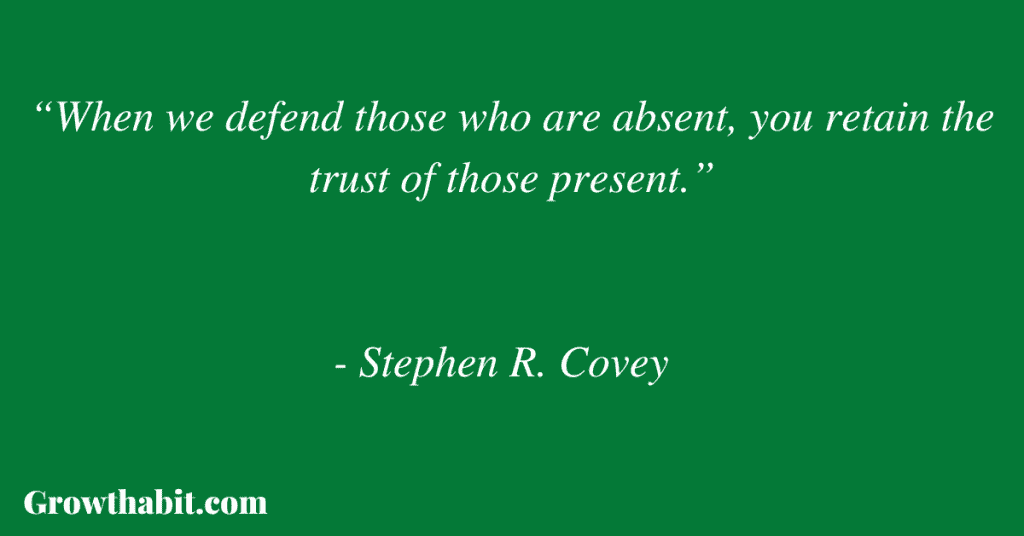
“if we can’t make and keep commitments to ourselves as well as to others, our commitments become meaningless. We know it; others know it. They sense duplicity and become guarded.”
Habit 7: Sharpen the Saw Principles of Balance and Self-Renewal
“Because Win/Win is a principle people can validate in their own lives, you will be able to bring most people to a realization that they will win more of what they want by doing for what you both want.”
Book Review (Personal Opinion):
The Seven Habits can serve as a set of guidelines not only for your own life but also for the lives of those who manage or lead other people. It is a tool for development on both a personal and a professional level.
It is a very enjoyable book, and the seven habits are laid out in a way that is easy to understand and put into practice.
We all engage in both positive and negative routines. We are self-aware of certain routines, but we are often oblivious to others until they are pointed out to us. On the other hand, you may apply the techniques presented by Covey to learn more about your unconscious habits. Covey looks at our habits from the point of view of how we can make our good habits stronger than our bad ones, rather than trying to get rid of our bad habits on their own. He is also aware of the fact that many beneficial behaviors do not always come naturally and must instead be acquired via practice. You have to connect with your core beliefs in order to be successful.
In contrast to many contemporary publications on self-help, it does not offer a quick remedy that may just mask or temporarily relieve the underlying issues. Instead, Covey walks you through a process that may be challenging for some of us and will need some effort on our part. The first three are focused on achieving what he calls a “private win,” which he says is necessary before you can effectively lead action teams at work, in your personal life, or in your business.
Rating: 10/10
If You Want To Learn More
Here is an interview with Stephen Covey:
“Tony Robbins Interviews Stephen Covey — Improve the Quality of Life & Career”
How I’ve Implemented The Ideas From The Book
This book has completely shifted my view on the acts I do and the degree of responsibility I bear for the role I play in the course of my life. Circumstances in one’s life will constantly present themselves and provide opportunities, sometimes in an understandable way, to escape duties or pledges. Covey cautions against doing so and argues that it is preferable to maintain one’s duties and, hence, one’s reputation. The most valuable insight that I gained from reading The 7 Habits of Highly Effective People was that “How you see the problem is the problem!” Simply shifting my viewpoint on the problems that were in front of me gave me the opportunity to relax mentally and emotionally and become a more passive spectator. As a result, I experience less stress and am more aware of the factors that contribute to it.
One Small Actionable Step You Can Do
Always go in the direction of climbing higher. There is always room for improvement. It’s crucial to both take stock of your progress and celebrate your successes. Maintain awareness of your progress toward betterment by keeping a record of your accomplishments. You can start to create a journal of your progress toward developing your desired traits and analyzing it weekly. Keeping track of your accomplishments can help keep your spirits up and drive you to keep pushing toward your goals.
